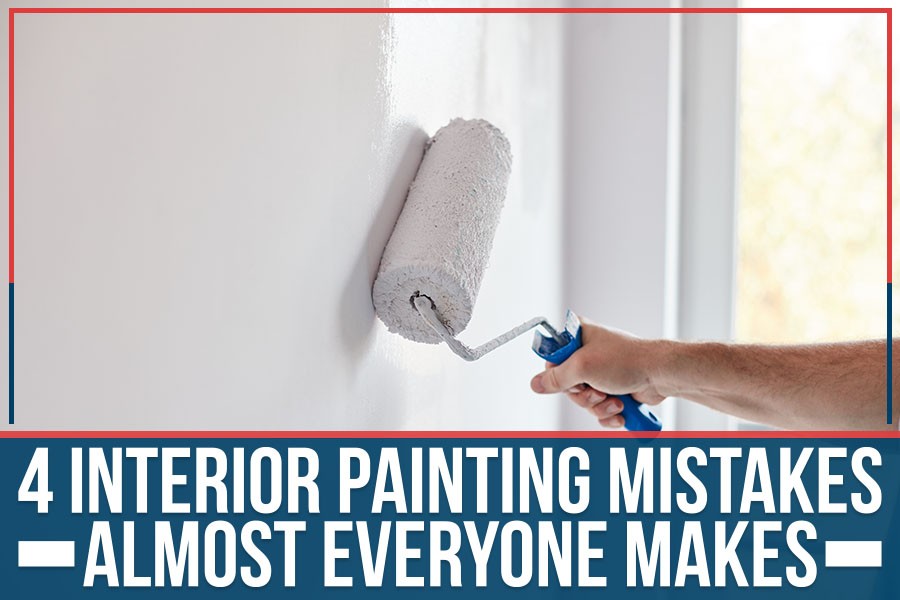4 Interior Painting Mistakes Almost Everyone Makes
From Ordinary to Extraordinary: the Magic of Complete Home Painting

Table of Contents
A home's aesthetic appeal is significantly influenced by its color scheme - an element that often goes unnoticed. This fundamental aspect of design, deeply rooted in the psychology of color, can transform a space from ordinary to extraordinary. The significance of such transformations extends beyond mere visual enhancement; it also impacts mood, perception, and interaction with the space. Hence, home painting should not be regarded as a simple task but rather an opportunity to evoke specific emotions and set the atmosphere within each room.
The process of planning and executing a complete home painting project involves several steps. It requires careful understanding and selection of colors based on their psychological implications as well as compatibility with existing furnishings and lighting conditions. Furthermore, choosing the right materials is crucial for achieving desired results while ensuring longevity. A meticulous approach to painting ensures precision and uniformity, while regular maintenance helps retain the fresh look over time. Each stage plays a vital role in transforming mundane spaces into aesthetically pleasing environments through the magic of paint.
Comprehending the profound influence of color in home painting necessitates an exploration into its psychological and aesthetic impacts, creating a transformative potential that transcends mere surface decoration. Color theory, a field deeply rooted in psychology, suggests that different hues can evoke varying emotional responses from individuals. For example, warm colors such as reds and yellows are often associated with energy and stimulation, while cooler tones like blues and greens invoke feelings of calmness or serenity. Moreover, the strategic use of color can dramatically alter perceptions of space; darker shades tend to make rooms appear smaller whereas lighter hues create an illusion of spaciousness.
Aesthetic appeal is also a significant factor underlying the power of color in home painting. From an architectural perspective, the selection of paint colors plays a crucial role in highlighting or minimizing specific design elements within a space. Consistent use of one hue or color family may unify disparate structures within a room, providing continuity and visual coherence. Conversely, contrasting shades can be employed to draw attention to unique architectural features or focal points within the space. Thusly observed, it becomes evident that complete home painting offers more than just refreshed walls; it presents opportunities for profound spatial transformation through careful manipulation of color effects both psychologically and aesthetically.
Initiating a successful refurbishment project requires meticulous planning, particularly when it pertains to changing the color scheme of your living space. The first step in this process is to define the scope of the undertaking, which involves deciding on the rooms to be painted and determining whether structural modifications are necessary. Next, a detailed analysis of the available wall surface needs to be conducted. This includes checking for damages that need repairing and identifying any pre-existing paint layers that might interfere with the new painting job. It is also imperative to choose suitable colors based on factors such as room function, size, natural light availability, and personal aesthetic preferences.
After establishing these parameters, developing a comprehensive budget becomes essential. The financial plan should consider not only direct costs like paint and supplies but also indirect costs such as labor if professionals are hired or time if it's a do-it-yourself project. Additionally, contingency provisions should be made for unexpected expenses that may arise during execution. Finally, devising an efficient schedule ensures that all tasks are completed in a timely manner without causing unnecessary disruption to daily household activities. Thus, through careful planning and preparation, an ordinary home can be transformed into a visually appealing space reflecting individual tastes and styles.
The selection of appropriate materials plays a pivotal role in achieving the desired outcome of any refurbishment project, particularly when it involves altering the color scheme of a living space. The choice of paint type, for instance, can significantly influence the final appearance and durability of the painted surface. Water-based paints are commonly used due to their ease of application, quick drying time, and environmental friendliness while oil-based paints provide a high-gloss finish with superior durability but require more skill to apply correctly. Additionally, selecting an appropriate primer is essential as it enhances paint adhesion, thereby reducing peeling and blistering.
In addition to paint and primer, proper selection of painting tools can also contribute to achieving an extraordinary finish. Brushes made from natural bristles are ideal for applying oil-based paint due to their ability to hold and evenly spread the denser pigment. Conversely, synthetic brushes work well with water-based paints as they do not absorb water like natural fibers do which could lead to brush damage over time. Rollers are suitable for covering large flat areas quickly while sprayers offer fast application but require significant prep work to protect nearby surfaces from overspray. The judicious selection and use of these materials can transform any ordinary room into a visually pleasing environment that reflects personal style and taste.
The painting process, an essential component of home renovation, involves critical stages that necessitate meticulous attention to detail. Firstly, the preparation of space is crucial in order to safeguard furniture and other items from potential damage caused by paint drips or spills. Secondly, understanding and implementing various painting techniques are pivotal not only for achieving a professional finish but also for enhancing the durability of the paint job.
Before embarking on a complete home painting project, it is essential to meticulously prepare the space, which involves tasks such as moving furniture, protecting floors and fixtures, and priming walls to ensure a smooth and flawless finish. The process begins with clearing the room of all movable items and furniture. This step not only prevents damage to personal belongings but also provides unrestricted access to all areas that require painting. For items that cannot be moved, like fixed cabinetry or heavy appliances, protective coverings such as drop cloths or plastic sheeting can be used.
Next is the task of safeguarding immovable objects and surfaces from paint splatters or spills by using masking tape along edges for protection. Particular attention should be given to flooring materials like hardwood or carpet which could suffer permanent staining if not adequately shielded. Additionally, wall surfaces must undergo rigorous preparation before applying any paint; this includes cleaning off any dust or grime accumulation followed by repairing cracks or holes using appropriate fillers. Priming the walls is a crucial preparatory step as well - it promotes paint adhesion resulting in smoother application while preventing stains from seeping through newly applied layers of paint.
Mastering various painting techniques is integral to achieving professional-quality results in any interior design project. These techniques ensure that paint is applied evenly and smoothly, thus enhancing the aesthetic appeal of a room. Techniques such as cutting-in, where the edges of a wall are painted first before filling in the middle section, can help achieve straight lines without the need for masking tape. Additionally, rolling—a technique involving a paint roller—ensures an even application of paint over large surfaces. Another key technique is stippling, which entails using a special brush to dab at wet paint to create texture and depth.
Moreover, understanding how different types of brushes and rollers interact with paint can significantly impact the final result. For instance, synthetic brushes work best with water-based paints while natural bristle brushes are ideal for oil-based paints. As for rollers, short-pile mohair types are suitable for smooth surfaces whereas long-pile sheepskin models excel on textured finishes like plaster or artexed ceilings. Furthermore, knowledge about drying times between coats and maintaining a 'wet edge'—a method where new strokes overlap slightly with still-wet paint—is crucial to prevent visible lines and streaks in the finish. Thus, these varied painting techniques transform ordinary spaces into extraordinary interiors when executed correctly.
Ensuring the longevity and freshness of a newly painted home requires regular maintenance and attention to detail. Regular cleaning is one way to maintain the aesthetic appeal of the paintwork, as accumulated dust and dirt can dull the vibrancy of the colours. Certain types of paint may also be more susceptible to damage from environmental factors such as sunlight or moisture, necessitating periodic checks for signs of deterioration or fading. In addition, it is recommended that homeowners avoid placing heavy furniture or fixtures against freshly painted walls to prevent scuff marks and other forms of physical damage.
Another essential aspect of maintaining a fresh look after complete home painting involves touch-ups. Over time, even with diligent care, inevitably some areas may show wear before others due to differences in exposure and use. Minute chips or cracks should be addressed promptly with matching paint to prevent further peeling or chipping. Moreover, using high-quality paints can provide better coverage and longer-lasting results, thereby reducing the frequency at which touch-ups are needed. Thus, through consistent upkeep activities like timely cleaning and prompt repairs, it is possible to extend the life span and retain the splendour of a meticulously executed paint job.
The transformation of a domestic environment through the strategic application and maintenance of color significantly impacts the aesthetic appeal and mood of a space. The careful planning and selection of proper materials ensures that this transformation is not merely temporary but has longevity.
Moreover, understanding the painting process itself proves to be an indispensable factor in achieving desired outcomes. Therefore, one can confidently assert that comprehensive home painting possesses the potential to transcend mediocrity and attain extraordinary results.
Author

Mason Marquis, raised in Newport Beach, California, and Austin, Texas, amalgamated his experiences from both vibrant cities in his journey. His academic pursuit in Economics and Psychology at the University of North Texas (UNT) led to the founding of Spray Tex Painting. This venture was not just a business for Mason but a practical application of his academic learnings, particularly the integration of economic concepts and psychological understanding. Spray Tex Painting, under Mason's direction, transcends being merely a painting service; it's a platform where client visions are realized through dedication and creativity.
Related Articles

4 Interior Painting Mistakes Almost Everyone Makes

4 Tips For Upgrading The Paint At Your Food Joint

5 Unique Texture Painting Ideas to Add Depth to Your Walls

A Comprehensive Approach: Unveiling the Whole-house Paint Services